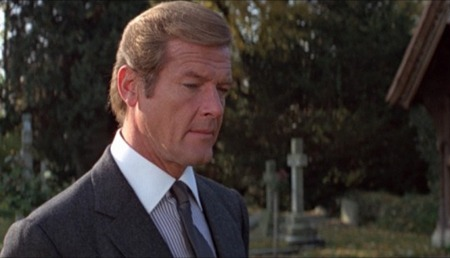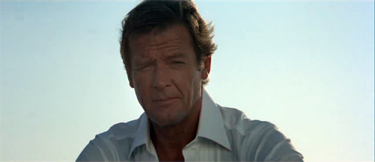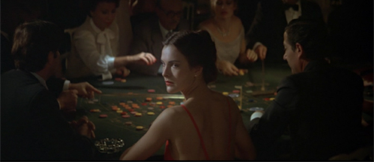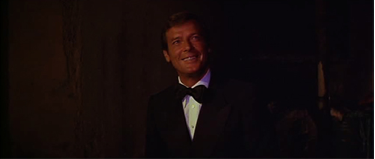For Your Eyes Only: Senescence in FYEO
By Krissy Myers (@krissy_myers)

After the extravagant and financially successful but critically panned release of 1979’s Moonraker, the creative team at EON Productions decided to take James Bond back to basics. With John Glen, a new director at the helm, 007 boldly entered the 1980’s with the straightforward spy thriller For Your Eyes Only. No more Jaws, Bondulas, outer space laser tag, implied space orgies or explicit attempts at re-entry by our lecherous but loveable Bond, Roger Moore.

“How could I bite off such a lovely face?”
Aside from a few throwaway moments, For Your Eyes Only succeeded in doing exactly what it set out to do. It was well received by critics at the time and is generally viewed as proof by Bond fans that Moore could be a serious spy when the opportunity was presented. This is how most reviews and essays praise this particular Bond film, and I’m in agreement. I’m not certain, however, that my particular reasoning behind this belief has ever been addressed in a demonstrably positive light. On the contrary, my feelings are rooted in the most ubiquitous criticism about the latter Roger Moore era.
First, a look at the opening scene.
After the gun barrel sequence, a graveyard becomes the very first shot of For Your Eyes Only. A man walks in the distance. He approaches a grave with a bouquet of red roses.
Teresa Bond, beloved wife of James Bond? She who died in 1969? James Bond’s face hasn’t yet been revealed and already we have the first overt reference to the events concluding On Her Majesty’s Secret Service presented in the Bond series to date. FYEO: not messing around! Let’s have a look at the Bond reveal, shall we?

Bond looks more distinguished. Mature even. If you were a REAL detractor, you would probably say something along the lines of “Roger Moore is too old to play James Bond now.” To my beloved Moore detractors, I ask you but one question:
How old is James Bond, anyway?
Unfortunately, there isn’t a clear-cut answer to this question in the novels let alone the films. Without going into too much detail, the Literary Bond was born on or around the 11th of November in either 1920, 1921 or 1924. Others have suggested that the birth of Movie Bond remained November 11th, but later, in 1930, to match Connery’s year of birth. Without making too forceful an assertion, 1930 seems to be an appropriate choice. Not to mention, if you were to add each Bond’s respective years of birth (Lazenby being born in 1939 and Moore in 1927) and derive the average, you would get 1932. It’s safe assume then that in Dr. No James Bond was in his early to mid thirties.
With the first reference to Tracy Bond since her death, her tombstone heavily implies that the James Bond in On Her Majesty’s Secret Service is the very same Bond in For Your Eyes Only. On top of that, it’s suggested in OHMSS that this Bond was the same Bond in Dr. No and beyond when Bond was seen going through his desk. The hard date on Tracy’s tombstone along with the desk scene, indicates that James Bond was the same man in every film and series continuity up until this point occurs in real time. If we can suspend our disbelief just slightly in regards to George Lazenby’s portrayal of Bond in OHMSS and consider Sean Connery’s return to the role in 1971’s Diamonds Are Forever and if James Bond was 30-35 years old in 1962 and the Bond films happen in real time, then in 1981 James Bond would have been between the ages of 49 and 54 years of age. As I mentioned before, Roger Moore was born in 1927, which would have put him at the age of 53 at the time of FYEO’s release.

Okay, so you’re technically the right age to play Bond. Why do you have to be so smug about it?
Honestly, I have absolutely no idea whether or not that this was on purpose, but if a creative team chooses to start a film with a widowed, visibly older James Bond in a graveyard, laying flowers on the grave of his wife who passed away 12 years ago, it’s not too farfetched to assume that a motif was fermenting there: James Bond, the character and the franchise, was starting to get old. In FYEO, senescence, beyond the pre-credit sequence, isn’t something that’s explicitly explored or touched upon through the film in a superficial, “I’m getting to old for this business,” manor. That would be too jarring for an audience keen on a more youthful, exuberant portrayal of the character. Bond still scuba dives, drives cars with reckless abandon and scales steep cliffs. The notion of an aging Bond is explored in the three distinct relationships that he has with women throughout the film.
Bibi Dahl

“I said get off of me. Not get off on me.”
The one character that comes the closest to a Bond-is-getting-old joke is the precocious teenage figure skater Bibi Dahl. She seems less focused on winning Olympic Gold and more interested in seducing a much older 007. Although slightly older than her character, actress Lynn-Holly Johnson bares a resemblance to Lolita‘s Sue Lyon in physical appearance and demeanor. In an act, beyond attraction to Bond, but perhaps as self evidence of her own perceived maturity, Bibi sneaks into his room and slips under the overs of his bed, nude, upon him entering his suite. Bond made the obvious wise choice in not allowing himself to be seduced, but didn’t ignore her advances either. With the suggestion of buying an ice cream, Bond the Lothario became Bond the chaperone.
As irritating Bibi becomes, it displays Bond’s maturity as well as Moore’s penchant for chivalry (as mentioned in my previous My Favorite #Bond_age_ essay for The Spy Who Loved Me), considering the young lady’s needs and desires. Despite Bond, well, being Bond, he understood that Bibi probably was just looking for attention from someone older. That’s something many teens, my teenage self included, do for a variety of reasons. Rather than take advantage or ignore her totally, Bond indulges her in a non-threatening way, if only somewhat begrudgingly. It was a very paternal gesture on Bond’s part, which would have probably played out differently had Bond been younger.
Countess Lisl von Schlaf

“Side boob? I’ll give you more than side boob.”
The scenes between Bond and Countess Lisl von Schalf serve as the most typical 007 relationship in FYEO. The perceived villain sent his mistress, Lisl, to seduce and extract information from James. It wasn’t a great deviation from previous Bond films aside from Lisl being a more mature woman. The “nightie” exchange conveys a tinge of nostalgia and a common origin shared between her and Bond.
“Oh, my nightie almost slipped!”
“So did your accent. Let me guess, Manchester?”
“Almost. Liverpool.”
Both were older, from the same country and took an instant liking to each other: each a respective beacon of familiarity among the exotic locals and pretty young things in the movie. The Countess is a breath of fresh air for Bond and the pacing and tone of the film, at least initially. An easy going, assured, mature lady who stays up at night and has champagne and oysters sitting in her fridge, making it all too easy for Moore’s Bond to do what he does best: be a magnificently smooth bastard. Not to mention, Bond has always been fond of falling into an obvious trap. No wonder he seemed so despondent when he found Lisl dead on the beach. His scenes with Lisl were really the only part in the film up that point where he got to have any fun.

“Goodbye, Countess.” Aww, Sad Bond is sad.
One character in particular probably wasn’t entirely sad when the poor Countess met her untimely end.

The above is a shot of Melina at the casino, watching Bond leave with Countless Lisl. She wasn’t too thrilled about it.
Melina seems to be a sort of middle ground between Bibi and The Countess in age and in terms of how she interacts with Bond. Their relationship begins as mostly platonic and remains that way for the majority of FYEO, but by the end, they engage in one of the more beloved Bond tropes: making whoopee on a boat. Something about this particular Bond film, which presses on my mind, is this: why did Melina and James suddenly end up getting romantically involved at the end of FYEO? Was it merely because it was a prerequisite for a Bond’s Belle Du Jour to have sex with 007 at some point during the film or was there a deeper reason for it?
The other and much more prevalent motif in FYEO is revenge; avenging Tracy’s death in the pre-credit sequence against not-Blofeld and the driving force behind Melina’s character in getting revenge for the death of her mother and father. Melina and Bond initially cross paths because Melina’s father was contracted by MI6 to retrieve the ATAC machine (the movie’s McGuffin) before the Russians. After a few close calls and an unglamorous car chase with the Citroen 2CV, Bond and Havelock… wax poetic on the nature of revenge?
“The Chinese have a saying: Before setting off on revenge, you first dig two graves.”
“I don’t expect you to understand, you’re English, but I’m half Greek and Greek women like Electra always avenge their loved ones.”
Certainly Bond was very knowledgeable about revenge. He was more than willing to share such knowledge with Melina, but not anything, which may be concealed in his pants. They meet several times throughout the film and rather than Moore taking Havelock back to his room for some sexy time, he advices Melina to essentially, stay out of harm’s way. Moore’s chivalrous, paternal instincts rear their head once more.
Melina’s mention of Electra was interesting as well. Sure, she was of Greek origin and it was an apt comparison, but in my observations, any mention of Electra in this sort of context tends to be shorthand for Daddy Issues in modern popular culture.
A capable, mature-for-her-age woman becomes fixated on an older, even more capable, sophisticated man due to deep-rooted issues, usually involved with death or abandonment, with their Father. It’s an old trope that fits neatly in FYEO. Melina was a capable, mature-for-her-age woman avenging the death of her Father; and Bond was an older, capable and sophisticated man. Moore’s Bond especially fits that description. It was a deep and radical prospect for Melina (and I suppose to an extent Bibi as well), to be sexually attracted to James for reasons beyond him being a sexy, vigorous man’s man. I think that the creatives on this film realized that this was a little more difficult to pull off with an aging Roger Moore. With Bibi it was played for laughs, but with Melina it was a little subtler – just dim enough for audiences not to notice right away.
The screen shot I used to show Melina’s disapproval of Bond leaving with Countless Lisl makes a bit more sense now, doesn’t it? Bond played adviser to her throughout the film and for reasons I cited previously, it was not too much of a stretch for her to become attached to him. To have had someone like Bond so readily fill that gap at a point where she was psychologically compromised with avenging her parent’s death, it wasn’t especially unusual for them to finally hook up at the end once Kristatos was finally killed by Colombo. There was even a nifty deleted scene where James returns to Melina’s boat and she brings up his rendezvous with the Countess (which can be viewed here at the 2:15 mark if you don’t own the BluRay: http://www.youtube.com/watch?v=z1c-Q0-w76Y)
“I called your hotel. You weren’t there.”
“Didn’t get back there last night.”
“I’m not interested in your sex life, Mr. Bond.”
“My sex life is not what I came here to discuss.”
Oh yeah, she went there. Bond wasn’t pursuing Melina. Melina was pursuing Bond. While she succeeds, it’s still extremely interesting that Bond went for only the most mature, sophisticated lady right away. That was a definite hallmark of his age.
Ultimately what I’ve been trying to express is this:
Not only did Roger Moore’s Bond work because he was older, but his age lends gravitas and complexity to the role.

“Thank you, Krissy.” You’re welcome, Roger.
He was too busy, too focused and too old to lightly fool around with pretty young things. Bond simply wanted to get the job done. This cooler, but still sympathetic, witty and chivalrous portrayal served as the one moment in his tenure where Moore managed to strike a balance between Ian Fleming’s pensive and melancholy Bond of the novels and his own personal interpretation. Roger may have found himself in the role in The Spy Who Loved Me, but it was in For Your Eyes Only where he truly mastered the character and successfully took Bond to a place where he’d never been before: over the hill. I understand why that might make some Bond fans feel a bit uncomfortable, but maybe the reason contemporary Moore detractors cite his advancing age as a flaw is routed in personal tastes and beliefs. I feel that this criticism is a bit shallow and does a disservice to Bond’s credibility as a character. It’s the only reason I can think of that Bond fans have the audacity to dictate that Bond cannot be a convincing and compelling sexy super spy because of his age. James Bond is more than a serial womanizer, cheap thrill and license to kill. Roger Moore and For Your Eyes Only went above and beyond in proving that.
First Bond Movie: Thunderball.
Favorite Bond Actor: HAH!
Favorite Bond Girl: Teresa Di’Vicenzo from On Her Majesty’s Secret Service. Guilty pleasure goes to Pam Bouvier from Licence To Kill.
How I Discovered #Bond_age_: Through the James Bond tag on Tumblr.
First #Bond_age_ Live Tweet: Strangely enough, The Spy Who Loved Me. How appropriate!

